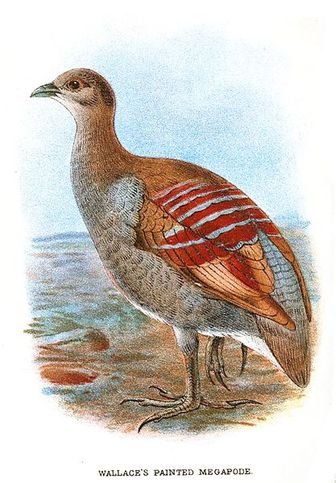Moluccan megapode
An Indonesian endemic, the Moluccan Megapode is confined to hill and mountain forests Maluku Islands of Halmahera, Buru, Seram, Ambon, Ternate, Haruku and Bacan. It also found in Misool Island of West Papua province.

The Moluccan megapode is classified as Vulnerable (VU), considered to be facing a high risk of extinction in the wild.
monotypic, but the Moluccan Megapode is sometimes placed in Megapodius instead. Both sexes are similar with an olive-brown plumage, bluish-grey below, white undertail coverts, brown iris, bare pink facial skin, bluish-yellow bill and dark olive legs. There are light grey stripes on reddish-maroon feathers on its back. The young has brownish plumage, a black bill, legs and hazel iris. More
Moluccan Megapode, Moluccan Scrubfowl Common Names in French: Mégapode De Wallace Description - Habitat Ecology: It inhabits dense, evergreen rainforest, also occurring in degraded forest and coastal scrub , from sea-level to 2,000 m although perhaps more typically above 750 m, except when nesting. More
The Moluccan Megapode Megapodius wallacei uses heat generated by the sun to incubate its eggs. It buries the eggs deep in the sand of sun-exposed beaches and open sandy areas on islands in the Moluccas, Indonesia. The eggs are laid at night and left to incubate for two to three months without parental care. We present evidence that the Moluccan Megapode exhibits lunar synchrony in the timing of egg-laying, its spatial distribution of egg burrows and in its behaviour at communal nesting grounds. More
Moluccan megapode ( Eulipoa Wallacei ), a fowl-type of bird, which lives in the tropical rainforests of the Moluccan Islands. Mr. Heij is a Dutch biologist, who obtained his doctors’ degree by writing a thesis on the sparrow – a bird a lot less exotic than the megapode!!! From earlier research conducted by Dr. More
The Moluccan megapode Eulipoa wallacei inhabits forests of several Moluccan Islands (Indonesia). The birds only leave this habitat for the purpose of egg-laying in self-dug burrows on sandy beaches, where solar heat incubates the eggs. The eggs are collected, sold and consumed by local people, a tradition that is said to threaten the species' existence. More

